
Cassinia is a genus of about fifty-two species of flowering plants in the family Asteraceae that are native to Australia and New Zealand. Plants in the genus Cassinia are shrubs, sometimes small trees with leaves arranged alternately, and heads of white, cream-coloured, yellow or pinkish flowers surrounded by several rows of bracts.
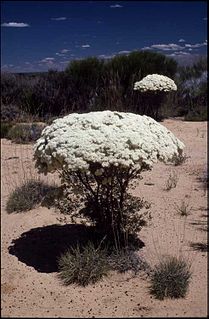
Verticordia brownii, commonly known as pink brownii or pink cauliflower is a flowering plant in the myrtle family, Myrtaceae, and is endemic to the south-west of Western Australia. It has small, neatly arranged, oval leaves and heads of pale pink to magenta or white flowers. It was one of the first verticordias to be collected, although it was not initially known by that name. The collection was made by Robert Brown on the Bass and Flinders circumnavigation of the Australian mainland on HMS Investigator.

Verticordia eriocephala, commonly known as lambswool, and common, native or wild cauliflower is a flowering plant in the myrtle family, Myrtaceae and is endemic to the south-west of Western Australia. It is a shrub with one densely branching, spreading main stem, small leaves and dense heads of creamy-white flowers, giving rise to the common names "lambswool" and "cauliflower". It is widespread over its range but becoming less common because of land clearing and illegal collecting of the flowers.
Verticordia capillaris is a flowering plant in the myrtle family, Myrtaceae and is endemic to the south-west of Western Australia. It is a shrub with a single stem at the base, small leaves and creamy white or occasionally pink flowers in dense corymb-like groups. It is common in small areas near Geraldton.

Homoranthus wilhelmii, commonly known as the eastern feather flower, is a species of flowering plant in the family Myrtaceae and is endemic to South Australia. It is a small, spreading shrub with cylindrical to flattened leaves and white or pink flowers arranged in corymbs on the ends of branchlets. The distribution includes an area on the Yorke Peninsula, but it is most common on the southern Eyre Peninsula.

Dillwynia cinerascens, commonly known as grey parrot-pea, is a species of flowering plant in the family Fabaceae and is endemic to south-eastern Australia. It is an erect to low-lying shrub with linear or thread-like leaves and orange or yellow flowers.
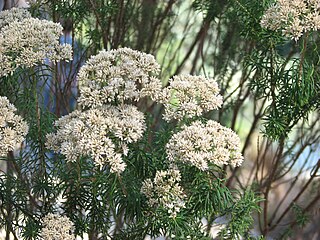
Cassinia aculeata, commonly known as common cassinia, dolly bush or dogwood , is a species of flowering plant in the family Asteraceae and is endemic to south-eastern Australia. It is an erect shrub with sessile, linear, variably-sized leaves, and heads of creamy-white to white flowers arranged in rounded cymes.

Cassinia arcuata, commonly known as drooping cassinia, biddy bush, Chinese scrub, sifton bush and Chinese shrub is a species of flowering plant in the family Asteraceae and is endemic to Australia. It is a shrub, sometimes a small tree with sessile, linear leaves, and heads of up to two hundred brownish flowers arranged in pyramid-shaped panicles. In New South Wales, the species is known as Cassinia sifton. In disturbed areas, C. sifton can become weedy.
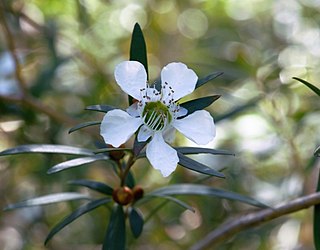
Leptospermum morrisonii is a shrub or small tree that is endemic to New South Wales. It has strongly aromatic, elliptical to lance-shaped or curved leaves, white or greenish white flowers and fruit that remain on the plant. It occurs in the south-east of the state.

Cassinia aureonitens, commonly known as the yellow cassinia is a species of flowering plant in the family Asteraceae and is endemic to eastern New South Wales. It is a shrub with elliptic leaves and heads of yellow flowers arranged in dense corymbs.

Cassinia cunninghamii, commonly known as Cunninghams everlasting, is a plant native to central New South Wales in eastern Australia.
Cassinia compacta is a species of flowering plant in the family Asteraceae and is endemic to eastern Australia. It is a shrub with densely hairy stems, linear leaves and heads of yellow flowers arranged in dense corymbs.
Cassinia decipiens is a species of flowering plant in the family Asteraceae and is endemic central New South Wales. It is a shrub with woolly-hairy young twigs, spreading, cylindrical leaves, and heads of creamy-brown to yellowish flowers arranged in a rounded cyme.
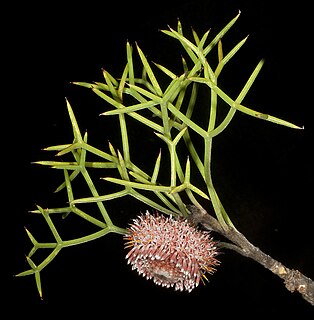
Isopogon teretifolius, commonly known as nodding coneflower, is a species of flowering plant in the family Proteaceae and is endemic to the southwest of Western Australia. It is an erect shrub with cylindrical, sometimes branched leaves, and flattened-spherical heads of hairy pinkish flowers.

Petrophile brevifolia is a species of flowering plant in the family Proteaceae and is endemic to southwestern Western Australia. It is a shrub with cylindrical, sharply-pointed leaves, and spherical heads of hairy yellow, cream-coloured or white flowers.
Petrophile incurvata is a species of flowering plant in the family Proteaceae and is endemic to southwestern Western Australia. It is a shrub with flattened, sometimes pinnately-divided leaves with up to five sharply pointed lobes, and cylindrical to oval heads of silky-hairy, cream-coloured to yellowish-white flowers.

Petrophile megalostegia is a species of flowering plant in the family Proteaceae and is endemic to southwestern Western Australia. It is a shrub with needle-shaped or flattened, sometimes S-shaped leaves with a sharply-pointed tip, and more or less cylindrical heads of silky-hairy, yellow to cream-coloured flowers.

Olearia oppositifolia is a species of flowering plant in the family Asteraceae and is endemic to eastern Australia. It is a shrub with egg-shaped to elliptic leaves arranged in opposite pairs, and white and yellow daisy flowers.
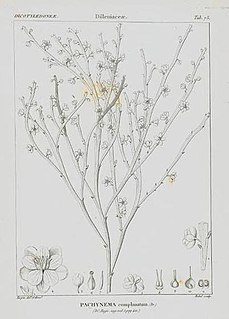
Hibbertia complanata is a species of flowering plant in the family Dilleniaceae and is endemic to the Northern Territory. It is a sub-shrub with two forms of erect, flattened stems, elliptic leaves and pinkish or creamy-white flowers arranged in leaf axils, with seven or eight stamens.
Cassinia accipitrum is a species of flowering plant in the family Asteraceae and is endemic to eastern New South Wales. It is an erect shrub with spreading, dark green leaves that are covered with cottony hair on the underside, and heads of yellowish brown flowers arranged in rounded cymes.













